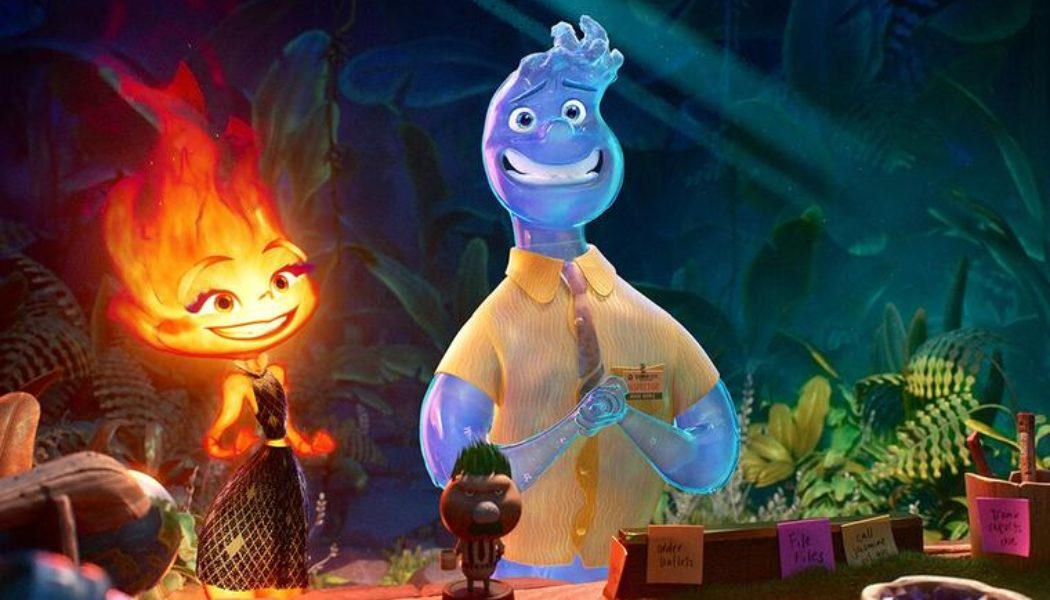
In 2011, storyboard artist Emma Coats, who had worked on hugely successful films including Up and Brave, tweeted out a list of what she called “Pixar’s 22 Rules of Storytelling.” Everybody in filmmaking pored over what was, in succinct fashion, the inside stuff that produced the wonders of Toy Story I-IV, The Incredibles, Finding Nemo, Monsters Inc., and the other 20 films that have made Pixar’s brand the most successful in cinema history.
The rules were a bit of a victory lap for the company whose library of films have consistently been brilliant in story and character, beautiful in visual landscapes, and hugely lucrative, with each project sending billions of dollars back to the Emeryville headquarters just east of San Francisco. Until now.
Pixar’s most recent offering, Elemental, opened to a dismal $29 million. That’s the worst opening ever for a Pixar film — by more than $10 million. The secular critics who are straining to hold up the film are still using words like “over-stuffed,” “inconsistent,” “predictable” and “mid-tier.” Certainly, the filmmakers are scratching their heads as to why families have rejected their offering. The short answer is that Elemental, as driven largely by a progressive political belief system, suffers from all the pitfalls so many earnest faith-based movies that tend to trump storytelling craft with messaging. The longer answer is that, probably due to complacency, Pixar has forgotten its brand such that Elemental astoundingly violates many of the company’s own defining “22 Rules of Storytelling.”
It’s difficult to even give a short synopsis of Elemental’s story, because it is so muddled. This breaks Pixar’s preeminent Rule 22, which is, “What’s the essence of your story? What is the most economical telling of it?”
This piece is more of a flashy hodge-podge than a story. The filmmakers desperately wanted to create a vision of a world where people who are different don’t mix, as an indictment of societal lack of diversity. So, somebody came up with the idea of anthropomorphizing the elements of fire, water, air and earth and designing separate but equal quadrants for all of them in some imaginary bustling metropolis.
The protagonist, Ember, is a young female from the fire quadrant whose whole goal is to learn to control her temper so she can run her parents’ shop one day. Along the way, she ends up falling in love with a water guy named Wade, and then the story switches gears and becomes about overcoming the facts of chemistry that are keeping them apart.
The visuals are certainly colorful and creative, but that’s never enough in a movie. The frames fly by flashing and spinning while the characters run around yelling at each other suffused with emotions the audience doesn’t share. Pixar’s Rule 5 demands that storytellers, “Simplify. Focus.” The impression Elemental creates is mostly confusion. The storytellers never bother to explain, what we call in screenwriting, “the rules of the arena.” How did this imaginary world come about? Who has the power here? And, crucially, why should we care about this place? That is, what is the story’s connection to our world?
Recall in Monsters, Inc. the genius of portal doors connecting the humans to the scarers. Or in Finding Nemo the contrast of the idyllic world of the reef and the world of the doctor’s office aquarium. As Rule 2 decrees: “You gotta keep in mind what’s interesting to you as an audience, not what’s fun to do as a writer.” There is no relatable connection in Elemental, just a very transparent metaphor of a broken “unwoke” society.
The sloppy story errors are replete. In the whole first act of the movie, Ember is racing to avoid a fine from a city bureaucrat in the hopes that her father will entrust her with the family store. Building a movie around correcting a snafu in urban infrastructure violates Pixar’s Rule 16, which says: “What are the stakes? Give us reason to root for the character. What happens if they don’t succeed?”
Even a little kid knows that if somebody doesn’t get a job, it’s not the end of the world. Ember’s two external quests in the movie — to run a shop and fix a wall — are what good storytellers call “unrelatable struggles.” Sitting next to me in the theater, the 6-year-old with the scrunched-up face put it best in asking her mother, “Why is the fire girl running after that guy?”
The end of the movie is patently absurd. Fire and water, according to their natures, cannot mix. Either the fire boils the water, turning it into gas; or the water puts out the fire. But see, that’s in the world where reality trumps all.
In the Elemental world, um, just east of San Francisco, personal will trumps reality. So, when Ember and Wade decide to cast all prudence to the wind and engage in a passionate embrace, the power of their minds and wills magically trumps the laws of physics. Again, the young girl beside me in the theater protested loudly, “Why doesn’t Ember boil up?” Rule 19 absolutely bans this kind of thing, noting, “Coincidences to get characters out of trouble are cheating.” Resolving a story through the “character-ex-machina” of mind over reality is never going to satisfy.
Pixar’s genius used to be layered plots that interweaved several characters’ arcs of transformation. The Incredibles managed to unfold six characters’ stories, all expanding on one overarching theme about how everyone needs to embrace their own giftedness. As a storytelling feat, that kind of complexity is, well, incredible.
Elemental, by contrast, has only two half-hearted sub-plots that aren’t layered but happen one at a time. Pixar Rule 9 encourages storytellers to fix story problems by making “a list of what WOULDN’T happen next.” That kind of creativity is nowhere apparent in the skeleton of formulaic frenzy that is meant mainly just to hold up the project’s message.
Truly inexcusable is Elemental’s roster of hackneyed, identity-politics-driven characters. We have Ember’s immigrant parents who are fleeing oppression. Then there are prejudiced working-class people who think the other elements should be avoided. Then, there is Wade, the effeminate metrosexual love interest. Finally, there’s Ember, the protagonist, an angry proto-feminist whose main challenge is overcoming societal bigotry by harnessing her innate personal power.
Ember’s appropriation of her parents’ dream for her for the first hour or so of the film violates Pixar’s Rule 13, which says, “Give your character’s opinions. Passive/malleable is poison to the audience.” Finally, because Ember’s various quests keep changing, we never see her strive in a meaningful way to grow. This violates Rule 1, which states, “You admire a character more for trying than for succeeding.” I would add that we admire a character for trying to do something that serves the world somehow, not just to please oneself.
It’s such a misstep. No kid wants to be Ember. Rule 6 insists that a story needs to demonstrate, “What is your character good at?” All Ember seems to be good at in this movie is rage. She gets so annoyed by other people’s cluelessness that she is continually burning up everything around her. But don’t judge her. In what is probably a weird nod to the riots that burned the hearts of several U.S. cities not long ago, the movie suggests that Ember’s anger is actually good: She shouldn’t be controlling her temper because her excesses of rage point to how her parents just don’t get it.
The thing is, Elemental is not really about Ember needing to fix a wall, run a shop and fall in love with a guy whose fundamental nature is to extinguish her. In the ultimate tragic departure of Pixar from its wonderful legacy, this project never really feels like the filmmakers care that much about the details of the plot. What they want to do, instead, is drive home two themes, one about rejecting your parents’ vision of life and the second about embracing people whom others tell you are dangerous. Or, in other words, “Love is love.”
Writing for The New Yorker — hardly a conservative bastion — Jessica Winter wryly notes, “the film’s aspirations as a parable of xenophobia and cross-cultural rapprochement might have had a better shot at landing if Ember didn’t so frequently set the creatures and things around her on fire.”
I can’t imagine anything more insulting to the folks at Pixar then coming to the realization that they have fallen into producing their own brand of irreligious propaganda. I’m being hard on them because they deserve it. They have been the best at creating family movies for the last two decades. They need to swear off using story to manipulate, and get back to using story to delight and illuminate. They need to dust off their famous rules and recommit to them. Especially, they need to brood over Rule 18 and figure out what is “the difference between doing your best and fussing.”









